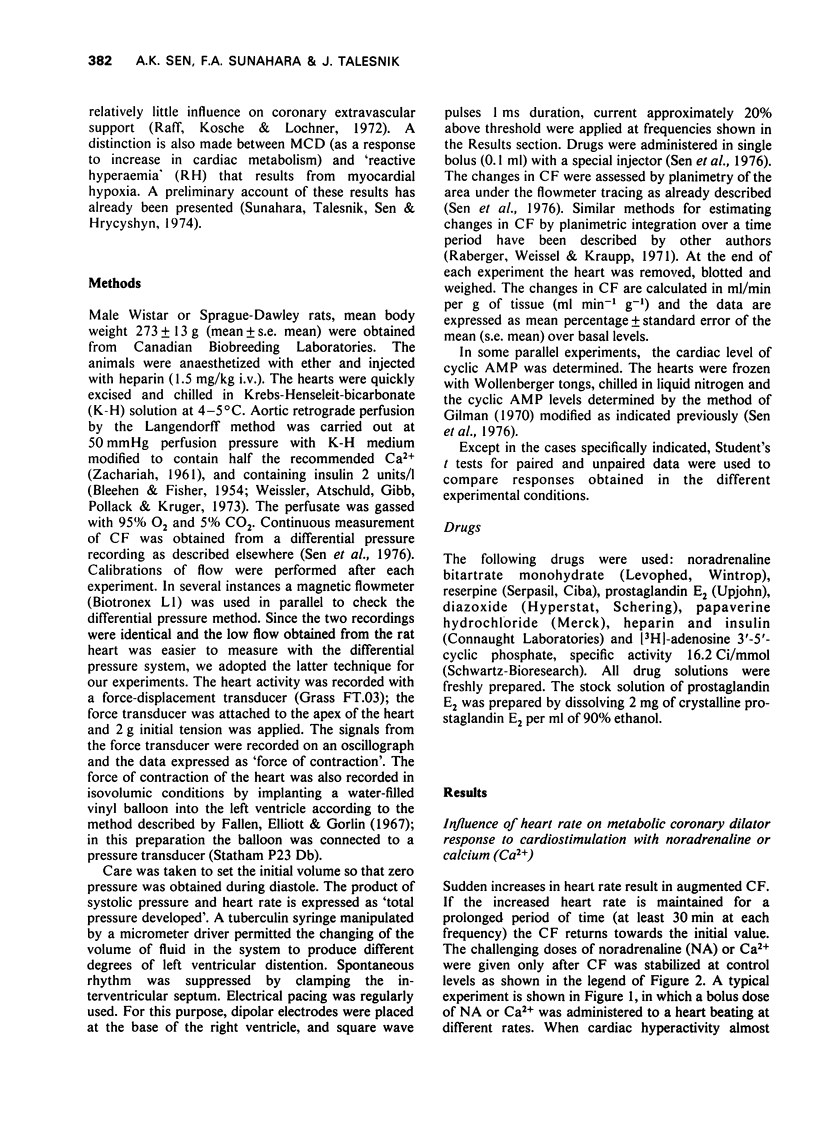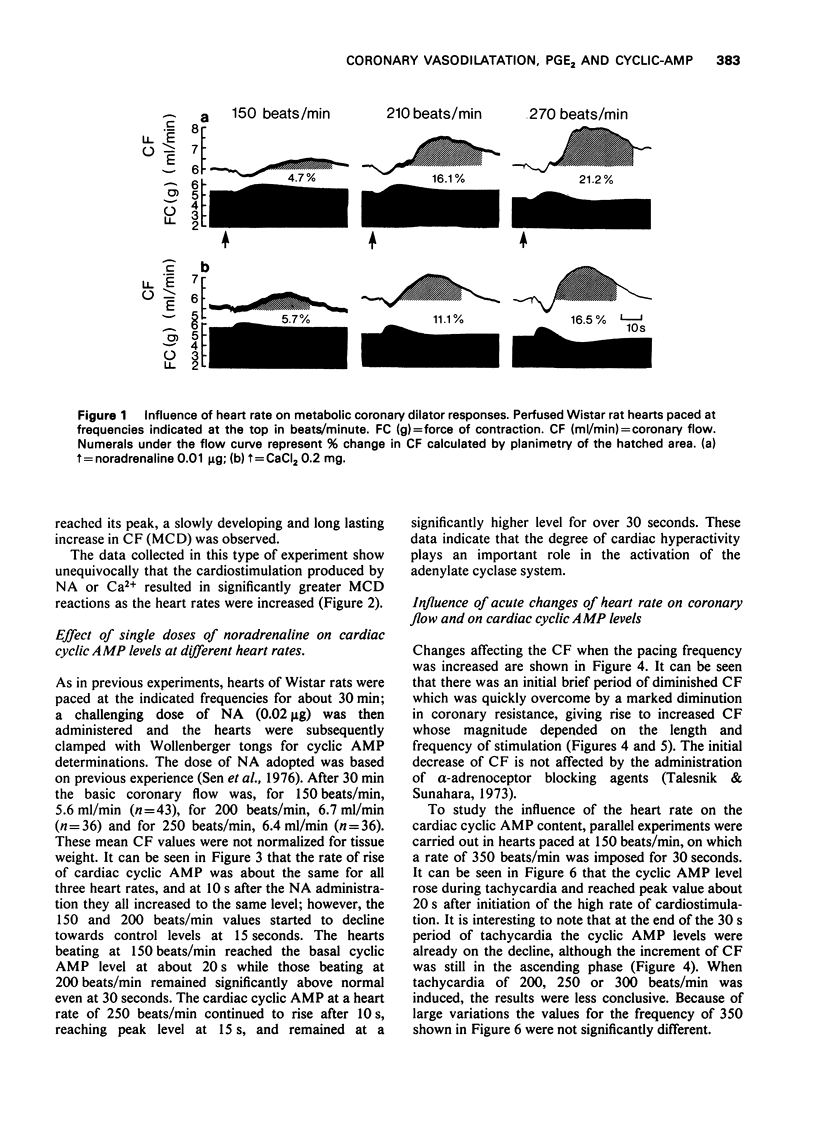Abstract
1. Continuous recording of cardiac force of contraction, heart rate and coronary flow from isolated perfused hearts of rats was used to study coronary reactions: (a) to cardiostimulation with noradrenaline, CaCl2, or electrically induced tachycardia; (b) to short duration stoppage of coronary inflow (hypoxia). 2. The heart rate was controlled by electrical pacing. Coronary vasodilatation resulted from cardiostimulation or hypoxia. This coronary response was greater at higher heart rates. 3. In parallel experiments administration of noradrenaline to hearts paced at different frequencies resulted in a rate-dependent elevation of adenosine-3',5'-cyclic monophosphate (cyclic AMP). 4. Duration of hypoxia leading to different degrees of reactive hyperaemia did not change the cardiac cyclic AMP levels. 5. Coronary vasodilatation due to increased cardiac metabolism produced by noradrenaline, Ca2+ or tachycardia was enhanced by the phosphodiesterase inhibitors diazoxide and papaverine while it was inhibited during the administration of prostaglandin E2.6. Reactive hyperaemia was unaffected by diazoxide, papaverine or prostaglandin E2. 7. Catecholamine depletion by reserpine did not influence metabolic coronary dilatation nor the reactive hyperaemic responses. 8. We postulate that there are at least two types of coronary reactions: one in response to hypoxia, 'reactive hyperaemia', and another resulting from cardiac hyperactivity, 'metabolic coronary dilatation'. The latter, blocked by prostaglandin E2 and enhanced by diazoxide or papaverine, would be triggered by cyclic AMP while reactive hyperaemia would result from other mechanisms.
Full text
PDF












Selected References
These references are in PubMed. This may not be the complete list of references from this article.
- Afonso S., Ansfield T. J., Berndt T. B., Rowe G. G. Coronary vasodilator responses to hypoxia before and after aminophylline. J Physiol. 1972 Mar;221(3):589–599. doi: 10.1113/jphysiol.1972.sp009769. [DOI] [PMC free article] [PubMed] [Google Scholar]
- Aporti F., Leon A., Toffano G. Anti-phosphodiesterase activity of the coronary dilating agent hydrochloride carbocromene. Pharmacol Res Commun. 1975 Jun;7(3):289–297. doi: 10.1016/0031-6989(75)90028-4. [DOI] [PubMed] [Google Scholar]
- BLEEHEN N. M., FISHER R. B. The action of insulin in the isolated rat heart. J Physiol. 1954 Feb 26;123(2):260–276. doi: 10.1113/jphysiol.1954.sp005049. [DOI] [PMC free article] [PubMed] [Google Scholar]
- Bache R. J., Cobb F. R., Greenfield J. C., Jr Effects of increased myocardial oxygen consumption on coronary reactive hyperemia in the awake dog. Circ Res. 1973 Nov;33(5):588–596. doi: 10.1161/01.res.33.5.588. [DOI] [PubMed] [Google Scholar]
- Bittar N., Pauly T. J. Myocardial reactive hyperemia responses in the dog after aminophylline and lidoflazine. Am J Physiol. 1971 Mar;220(3):812–815. doi: 10.1152/ajplegacy.1971.220.3.812. [DOI] [PubMed] [Google Scholar]
- Brink A. J., Bester A. J., Lochner A. A comparison of stimulation frequency and electro-augmentation on myocardial function, extensibility, coronary flow rate, oxygen consumption and glucose metabolism. Eur J Clin Invest. 1972 Jun;2(4):250–258. doi: 10.1111/j.1365-2362.1972.tb00652.x. [DOI] [PubMed] [Google Scholar]
- Broadley K. J. The release of a coronary vasodilator metabolite from the guinea-pig isolated perfused heart stimulated by catecholamines, histamine and electrical pacing and by exposure to anoxia. Br J Pharmacol. 1976 Sep;58(1):89–100. doi: 10.1111/j.1476-5381.1976.tb07696.x. [DOI] [PMC free article] [PubMed] [Google Scholar]
- Carafoli E. Mitochondria, Ca2+ transport and the regulation of heart contraction and metabolism. J Mol Cell Cardiol. 1975 Feb;7(2):83–87. doi: 10.1016/0022-2828(75)90010-3. [DOI] [PubMed] [Google Scholar]
- Cheung W. Y., Bradham L. S., Lynch T. J., Lin Y. M., Tallant E. A. Protein activator of cyclic 3':5'-nucleotide phosphodiesterase of bovine or rat brain also activates its adenylate cyclase. Biochem Biophys Res Commun. 1975 Oct 6;66(3):1055–1062. doi: 10.1016/0006-291x(75)90747-0. [DOI] [PubMed] [Google Scholar]
- Cobb F. R., Bache R. J., Curry C. L., Ebert P. A., McHale P. A., Greenfield J. C., Jr Sympathetic influences on coronary and aortic flow responses to increasing heart rate. Am J Physiol. 1973 Sep;225(3):538–545. doi: 10.1152/ajplegacy.1973.225.3.538. [DOI] [PubMed] [Google Scholar]
- Endoh M., Brodde O. E., Schümann H. J. Accumulation of cAMP and positive inotropic effect evoked by isoproterenol under the graded inhibition of phosphodiesterase by papaverine in the isolated rabbit papillary muscle. J Mol Cell Cardiol. 1975 Sep;7(9):703–711. doi: 10.1016/0022-2828(75)90147-9. [DOI] [PubMed] [Google Scholar]
- Entman M. L. The role of cyclic AMP in the modulation of cardiac contractility. Adv Cyclic Nucleotide Res. 1974;4(0):163–193. [PubMed] [Google Scholar]
- Fallen E. L., Elliott W. C., Gorlin R. Apparatus for study of ventricular function and metabolism in the isolated perfused rat heart. J Appl Physiol. 1967 Apr;22(4):836–839. doi: 10.1152/jappl.1967.22.4.836. [DOI] [PubMed] [Google Scholar]
- Forester G. V., Mainwood G. W. Interval dependent inotropic effects in the rat myocardium and the effect of calcium. Pflugers Arch. 1974;352(3):189–196. doi: 10.1007/BF00590484. [DOI] [PubMed] [Google Scholar]
- Gilman A. G. A protein binding assay for adenosine 3':5'-cyclic monophosphate. Proc Natl Acad Sci U S A. 1970 Sep;67(1):305–312. doi: 10.1073/pnas.67.1.305. [DOI] [PMC free article] [PubMed] [Google Scholar]
- Hanna P. E., O'Dea R. F., Goldberg N. D. Phosphodiesterase inhibition by papaverine and structurally related compounds. Biochem Pharmacol. 1972 Aug 15;21(16):2266–2268. doi: 10.1016/0006-2952(72)90043-3. [DOI] [PubMed] [Google Scholar]
- Huang M., Daly J. W. Adenosine-elicited accumulation of cyclic AMP in brain slices: potentiation by agents which inhibit uptake of adenosine. Life Sci. 1974 Feb 1;14(3):489–503. doi: 10.1016/0024-3205(74)90364-6. [DOI] [PubMed] [Google Scholar]
- Jageneau A. H., Schaper W. K., Van Gerven W. Enhancement of coronary reactive hyperemia in unanesthetized pigs by an adenosine-potentiator (Lidoflazine). Naunyn Schmiedebergs Arch Pharmakol. 1969;265(1):16–23. doi: 10.1007/BF01417207. [DOI] [PubMed] [Google Scholar]
- Kirchberger M. A., Tada M., Repke D. I., Katz A. M. Cyclic adenosine 3',5'-monophosphate-dependent protein kinase stimulation of calcium uptake by canine cardiac microsomes. J Mol Cell Cardiol. 1972 Dec;4(6):673–680. doi: 10.1016/0022-2828(72)90120-4. [DOI] [PubMed] [Google Scholar]
- Koyama T., Nakagawa K. The effect of hypoxia on the coronary blood flow in reserpinized dogs. Am Heart J. 1972 Oct;84(4):487–495. doi: 10.1016/0002-8703(72)90472-3. [DOI] [PubMed] [Google Scholar]
- Lee S. L., Balasubramanian V., Dhalla N. S. Excitation-contraction coupling in heart. XIX. Effect of hypoxia on calcium transport by subcellular particles in the isolated perfused rat heart. Can J Physiol Pharmacol. 1976 Feb;54(1):49–58. doi: 10.1139/y76-008. [DOI] [PubMed] [Google Scholar]
- Lefkowitz R. J., Levey G. S. Norepinephrine: dissociation of -receptor binding from adenylate cyclase activation in solubilized myocardium. Life Sci II. 1972 Aug 22;11(16):821–828. doi: 10.1016/0024-3205(72)90130-0. [DOI] [PubMed] [Google Scholar]
- Liu M. S., Feinberg H. Effect of persantin on nucleoside metabolism of the perfused rabbit heart. Biochem Pharmacol. 1973 May 1;22(9):1118–1121. doi: 10.1016/0006-2952(73)90177-9. [DOI] [PubMed] [Google Scholar]
- Lugnier C., Stoclet J. C. Inhibition by papaverine of cGMP and cAMP phosphodiesterases from the rat heart. Biochem Pharmacol. 1974 Nov 1;23(21):3071–3074. doi: 10.1016/0006-2952(74)90285-8. [DOI] [PubMed] [Google Scholar]
- McNeill J. H., Verma S. C. Blockade by burimamide of the effects of histamine and histamine analogs on cardiac contractility, phosphorylase activation and cyclic adenosine monophosphate. J Pharmacol Exp Ther. 1974 Jan;188(1):180–188. [PubMed] [Google Scholar]
- Miura M., Tominaga S., Hashimoto K. Potentiation of reactive hyperemia in the coronary and femoral circulation by the selective use of 2,6-bis(diethanolamino)-4,8-dipiperidino-pyrimodo[5,4-d]pyrimidine. Arzneimittelforschung. 1967 Aug;17(8):976–979. [PubMed] [Google Scholar]
- Moir T. W., Downs T. D., Eckstein R. W. The effect of alpha adrenergic block on adenosine- and ATP-induced coronary vasodilation. Proc Soc Exp Biol Med. 1973 Nov;144(2):517–522. doi: 10.3181/00379727-144-37626. [DOI] [PubMed] [Google Scholar]
- Moir T. W., Downs T. D. Myocardial reactive hyperemia: comparative effects of adenosine, ATP, ADP, and AMP. Am J Physiol. 1972 Jun;222(6):1386–1390. doi: 10.1152/ajplegacy.1972.222.6.1386. [DOI] [PubMed] [Google Scholar]
- Nakatsu K., Drummond G. I. Adenylate metabolism and adenosine formation in the heart. Am J Physiol. 1972 Nov;223(5):1119–1127. doi: 10.1152/ajplegacy.1972.223.5.1119. [DOI] [PubMed] [Google Scholar]
- Nayler W. G., Dunnett J., Burian W. Further observations on species-determined differences in the calcium-accumulating activity of cardiac microsomal fractions. J Mol Cell Cardiol. 1975 Sep;7(9):663–675. doi: 10.1016/0022-2828(75)90143-1. [DOI] [PubMed] [Google Scholar]
- Nayler W. G., McInnes I., Chipperfield D., Carson V., Daile P. The effect of glucagon on calcium exchangeability, coronary blood flow, myocardial function and high energy phosphate stores. J Pharmacol Exp Ther. 1970 Feb;171(2):265–275. [PubMed] [Google Scholar]
- Olsson R. A. Myocardial reactive hyperemia. Circ Res. 1975 Sep;37(3):263–270. doi: 10.1161/01.res.37.3.263. [DOI] [PubMed] [Google Scholar]
- Parker R. B., Waud D. R. Pharmacological estimation of drug-receptor dissociation constants. Statistical evaluation. I. Agonists. J Pharmacol Exp Ther. 1971 Apr;177(1):1–12. [PubMed] [Google Scholar]
- Pauly T. J., Zarnstorff W. C., Bittar N. Myocardial metabolic activity as a determinant of reactive hyperaemia responses in the dog heart. Cardiovasc Res. 1973 Jan;7(1):90–94. doi: 10.1093/cvr/7.1.90. [DOI] [PubMed] [Google Scholar]
- Pitt B., Gregg D. E. Coronary hemodynamic effects of increasing ventricular rate in the unanesthetized dog. Circ Res. 1968 Jun;22(6):753–761. doi: 10.1161/01.res.22.6.753. [DOI] [PubMed] [Google Scholar]
- Raberger G., Weissel M., Kraupp O. The dependence of the effects of i.cor. administered adenosine and of coronary conductance on the arterial pH, pCO 2 and buffer capacity in dogs. Naunyn Schmiedebergs Arch Pharmakol. 1971;271(3):301–310. doi: 10.1007/BF00997224. [DOI] [PubMed] [Google Scholar]
- Raff W. K., Kosche F., Lochner W. Extravascular coronary resistance and its relation to microcirculation. Influence of heart rate, end-diastolic pressure and maximal rate of rise of intraventricular pressure. Am J Cardiol. 1972 May;29(5):598–603. doi: 10.1016/0002-9149(72)90159-2. [DOI] [PubMed] [Google Scholar]
- Rubio R., Berne R. M. Release of adenosine by the normal myocardium in dogs and its relationship to the regulation of coronary resistance. Circ Res. 1969 Oct;25(4):407–415. doi: 10.1161/01.res.25.4.407. [DOI] [PubMed] [Google Scholar]
- Rubio R., Wiedmeier V. T., Berne R. M. Relationship between coronary flow and adenosine production and release. J Mol Cell Cardiol. 1974 Dec;6(6):561–566. doi: 10.1016/0022-2828(74)90036-4. [DOI] [PubMed] [Google Scholar]
- Samir Amer M., Kreighbaum W. E. Cyclic nucleotide phosphodiesterases: properties, activators, inhibitors, structure--activity relationships, and possible role in drug development. J Pharm Sci. 1975 Jan;64(1):1–37. doi: 10.1002/jps.2600640106. [DOI] [PubMed] [Google Scholar]
- Sano N. Enhancement of coronary vasodilating action of adenosine by dilazep and dipyridamole in the dog. Jpn J Pharmacol. 1974 Jun;24(3):471–478. doi: 10.1254/jjp.24.471. [DOI] [PubMed] [Google Scholar]
- Sellers E. A., Flattery K. V., Steiner G. Cold acclimation of hypothyroid rats. Am J Physiol. 1974 Feb;226(2):290–294. doi: 10.1152/ajplegacy.1974.226.2.290. [DOI] [PubMed] [Google Scholar]
- Sen A. K., Sunahara F. A., Talesnik J. Prostaglandin E2 and cyclic AMP in the coronary vasodilatation due to cardiac hyperactivity. Can J Physiol Pharmacol. 1976 Apr;54(2):128–139. doi: 10.1139/y76-021. [DOI] [PubMed] [Google Scholar]
- Simaan J. Left ventricular volume as a determinant of myocardial oxygen consumption. Cardiovasc Res. 1974 Jul;8(4):534–540. doi: 10.1093/cvr/8.4.534. [DOI] [PubMed] [Google Scholar]
- Steer M. L., Atlas D., Levitzki A. Inter-relations between beta-adrenergic receptors, adenylate cyclase and calcium. N Engl J Med. 1975 Feb 20;292(8):409–414. doi: 10.1056/NEJM197502202920809. [DOI] [PubMed] [Google Scholar]
- Sulakhe P. V., Dhalia N. S. Excitation-contraction coupling in heart. VII. Calcium accumulation in subcellular particles in congestive heart failure. J Clin Invest. 1971 May;50(5):1019–1027. doi: 10.1172/JCI106573. [DOI] [PMC free article] [PubMed] [Google Scholar]
- Sunahara F. A., Talesnik J. Prostaglandin inhibition of metabolically induced coronary vasodilation. J Pharmacol Exp Ther. 1974 Jan;188(1):135–147. [PubMed] [Google Scholar]
- Talesnik J., Sunahara F. A. Enhancement of metabolic coronary dilatation by aspirin-like substances by suppression of prostaglandin feedback control? Nature. 1973 Aug 10;244(5415):351–353. doi: 10.1038/244351a0. [DOI] [PubMed] [Google Scholar]
- Thomas R. A., Rubio R., Berne R. M. Comparison of the adenine nucleotide metabolism of dog atrial and ventricular myocardium. J Mol Cell Cardiol. 1975 Feb;7(2):115–123. doi: 10.1016/0022-2828(75)90013-9. [DOI] [PubMed] [Google Scholar]
- Vatner S. F., Braunwald E. Cardiovascular control mechanisms in the conscious state. N Engl J Med. 1975 Nov 6;293(19):970–976. doi: 10.1056/NEJM197511062931906. [DOI] [PubMed] [Google Scholar]
- Weissler A. M., Altschuld R. A., Gibb L. E., Pollack M. E., Kruger F. A. Effect of insulin on the performance and metabolism of the anoxic isolated perfused rat heart. Circ Res. 1973 Jan;32(1):108–116. doi: 10.1161/01.res.32.1.108. [DOI] [PubMed] [Google Scholar]
- ZACHARIAH P. Contractility and sugar permeability in the perfused rat heart. J Physiol. 1961 Sep;158:59–72. doi: 10.1113/jphysiol.1961.sp006754. [DOI] [PMC free article] [PubMed] [Google Scholar]


